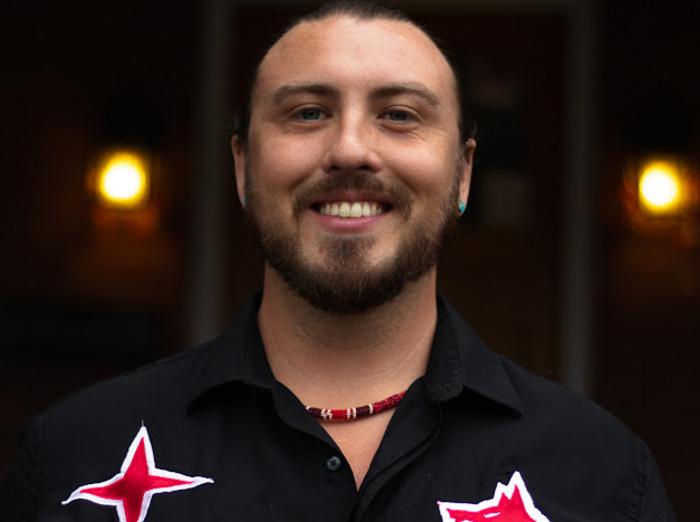LAWRENCE — A book co-edited by a University of Kansas scholar that collects the experiences and know-how of younger Indigenous archaeologists, titled “Indigenizing Archaeology: Putting Theory into Practice,” is newly published by the University Press of Florida.

Credit: First Nations and Education Center at Indiana University
LAWRENCE — A book co-edited by a University of Kansas scholar that collects the experiences and know-how of younger Indigenous archaeologists, titled “Indigenizing Archaeology: Putting Theory into Practice,” is newly published by the University Press of Florida.
Carlton Shield Chief Gover, acting assistant professor of anthropology and acting assistant curator of archaeology at KU, conceived and co-edited the new volume. Its chapters include lessons and case studies from the discipline.
“This is the first book to our knowledge completely comprised of Indigenous scholars in archaeology, including our copy editors,” said Shield Chief Gover. “What makes this form of archaeology different within the field is its methods. This book is the ‘how-tos’ of Indigenous archaeology. It reflects how different people from different tribes do their version of archaeology. There’s not just some monolith of Native Americans. Rather, each nation has its own way of doing archaeology based on their own cultural practices.”
Shield Chief Gover said the book’s contributors were mostly scholars in early stages of their careers.
“My colleague and co-editor (Emily Van Alst, anthropologist at Washington State University) and I started this project when we were early in our Ph.D.s,” he said. “Everyone’s contributions in this volume are based either on their master’s thesis or doctoral work. So, we’re all junior academics reflecting on how we were able to get through school and the methods that it took.”
According to Shield Chief Gover, the new tome is geared toward a general readership as a practical guide to Indigenous archaeology rather than a theoretical treatise. He said the rise of the field of Indigenous archaeology can be traced to passage of the Native American Graves Protection and Repatriation Act in the 1990s.
“That’s what forced archaeologists and Indigenous people to sit down at the table with one another as equals to actually explore, ‘OK, well, how do we get these individuals and their grave goods back home to their communities — and which communities do they belong to?’” he said. “A lot at the base level of Indigenous archaeology is communication and collaboration. It’s just engaging with the communities that you used to do research ‘on.’ Now you’re doing research ‘with’ and having communities incorporated from beginning to end so they’re part of the entire process, not just this little back-end piece, which was called ‘consulting.’ You did all the work; you did the research questions. Then, at the end you’d ask, ‘OK, hey, what do you guys think about this?’ You know, just to check a box.”
Shield Chief Gover said his fellow contributors’ insights and experiences especially benefit Indigenous cultural staff at institutions around the country and internationally.
“We’re hoping this book could be a tool for them to replicate our work through their own nationhood and to move their nations forward with archaeology,” he said. “It’s really distinct from what’s been published before, which have been mostly theoretical ideas by well-established authors writing for scholars in this field. But our book is meant for the average NAGPRA officer or tribal historic preservation officer or early rising students in the field of archaeology, both Indigenous and non-Indigenous.”
Shield Chief Gover’s own contributed chapter reflects on his experiences as a graduate student on his way to becoming the first Pawnee academic archaeologist (as well as a member of a profession that often collided with Indigenous interests historically).
“It was difficult,” said the KU researcher. “My chapter reflects on how I did my master’s thesis. I struggled to communicate my thesis to my community and family, because it was so dense with statistics and the lexicon. So, I really looked at this chapter as an opportunity to say, ‘Well, this is how I went about it. This is why this is important. This is what it means. And this is how other cultural staff can utilize it to serve their own tribes’ purposes.’ At Wyoming, I was the only Indigenous graduate student there. I didn’t even know there was a field of Indigenous archaeology.”
Shield Chief Gover said it wasn’t until he started working on his doctorate later at the University of Colorado at Boulder that he encountered a body of scholarly work by Indigenous archaeologists. In part, he hopes his new volume will make the field more accessible to young academics in a similar position.
“Until then, I had no idea of these resources — I was just on my own, or at least I thought I was,” he said. “Then I realized there was already literature about Indigenous archaeology and there were already people doing what I had ‘Forrest Gumped’ myself into on my own. I felt having a book dedicated less to the theory, but more to the methods would help other folks realize, ‘Oh, this is the actual nuts and bolts of how to do this’ — rather than, ‘Well, this is why you should do it and why it’s important.’ Instead, we talk about where the rubber meets the road.”
To ensure the volume will be available to all with an interest in Indigenous archaeology, Shield Chief Gover and his colleagues made a point of providing a digital open-access copy.
“You can get an online copy of this book for free from the University Press of Florida,” he said. “We wanted to make our content freely accessible to disadvantaged communities that might not have $30 to spend, and we really wanted this accessible to cultural staff in Indian Country so they can readily have it to be employed by their offices.”



